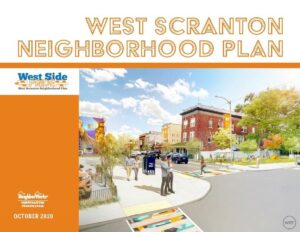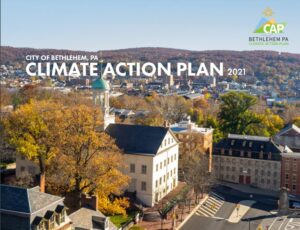The Latest News from PA Chapter of APA…
October is always a special month for planning in Pennsylvania, when our annual conference is held and national community planning month is celebrated. We had a great annual conference in Pittsburgh this year, and two of our 2021 award winners from the conference are highlighted below – West Scranton and Bethlehem. Enjoy these and other articles this month! Enjoy!
Educational Opportunities

Transit Supportive Community Development
Frequent, all-day transit service is only one piece of the puzzle in creating a seamless, total lifestyle transit network, which is a key goal set in SEPTA Forward, the Authority’s Strategic Plan. We also need to ensure that development near stations and along frequent transit corridors supports ridership. To do so, SEPTA is launching a comprehensive Transit Supportive Community Development program to promote equitable, mixed-use development that improves safety, ensures environmental justice and sustainability, and creates a seamless network of multimodal transportation options, among other critical goals. This program will support SEPTA’s efforts to implement their Strategic Plan and aligns with the Authority’s vision of transit at the core of our region. Join us for a panel discussion on Wednesday November 3rd at noon to learn more about SEPTA’s new initiative and hear from transit-oriented development practitioners from Pennsylvania and a special guest from the San Francisco region on best practices. CM credit is pending approval. Deadline to register is November 2, 2021
If you’re interested in sponsoring a Webinar Wednesday session or have a session for Webinar Wednesday, please contact us. Send your request to info@planningpa.org.
More Educational Opportunities:
- Law and Ethics Distance Education Sessions: For APA members that still need law and ethics CM credit distance education sessions are available. American Planning Association will be offering credit till the end of the year.
- Ethics for Planners (CM #9212131)
- Public Art Life Cycle: Concept to Commission (CM #92192195)
Opportunities for Giving
Each year the Chapter offers a scholarship to support individuals seeking funds for academic degree programs, internships, and professional development activities. If anyone would like to contribute to the Chapter’s Scholarship fund, donations can be made here. We accept all major credit cards, or you can send a check. Please make your check payable to “PA Chapter of APA Scholarship Fund” and mail it to P.O. Box 4680, Harrisburg PA 17111.
Uncharted Lancaster Using Adventure to Engage

Uncharted Lancaster’s founder Adam Zurn along with a treasure cache
You could say that Uncharted Lancaster is where National Treasure meets local history and geography. This fun and approachable online blend of information and adventure began about three years ago, with founder Adam Zurn needing a good place to walk his dogs. He started with the nearby Shenks Ferry Nature Preserve, mostly known today for its profusion of spring wildflowers, and slowly uncovered an incredibly rich history– among them a 300-year old cemetery, rumored ghosts, industrial ruins, and the site of the deadliest manufacturing accident in Lancaster history. Amazingly, much of this wasn’t documented online in any way that would facilitate visiting.
Zurn is not a professional planner. He teaches school, and not the history classes you might expect. Instead, he leads technical ones like website design and 3D printing and these are the skills he brings to his personal interest in local history. Uncharted Lancaster is the resulting website and related social media accounts that take that interest, give it a gloss of treasure-seeking, and send it out to the world wide web, where it can inform on-the-ground and armchair explorers alike.
Adventures and quests frequently take seekers to little-known sites with clues that lead to caches of 3D-printed medallions or other small, collectible treasures. Other posts are purely informative, and make sites that are difficult or dangerous for most to access – like petroglyphs in the middle of the Susquehanna River at Safe Harbor – easy to experience in a safe, convenient way. This virtual exploration has the added benefit of reducing impacts that even visitors with the best of intentions have on sensitive resources and environments.
Planners can easily adapt this playbook to educate and engage communities. Zurn, for example, partners each year with the Lancaster County Conservancy to highlight Water Week. In this adventure, explorers visit green infrastructure projects in Lancaster City. As people follow the 3-mile circuit, they interact with educational information online and collect clues in the built environment to unlock the hidden treasure’s location.
Professional planners, especially ones that run social media accounts, may be skeptical that small incentives – even really fun ones – can drive regular engagement, but Zurn encourages us not to overlook the “collector” dynamic that drives many people, and gamers in particular, to consistently interact with content. We’ll explore this and other online engagement tips in an in-depth article next month. In the meantime, check out Uncharted Lancaster’s website and Facebook page to get a sense of the potential.
West Scranton Neighborhood Plan
West Scranton is located west and north of downtown Scranton, along the western side of the Lackawanna River and bordering Taylor Borough and Ransom Township in Lackawanna County. West Scranton is unique in that it is situated very close to downtown Scranton; however, limited street connections and physical barriers have resulted in the neighborhood developing its own independent character and culture over time.
 In 2019, NeighborWorks of Northeastern Pennsylvania was awarded a Wells Fargo Regional Foundation planning grant to complete a neighborhood revitalization plan for the West Scranton area. NeighborWorks Northeastern Pennsylvania provides multiple community services in West Scranton, including financial coaching and education, homebuyer education, property acquisition and redevelopment, aging in place assistance, and overall neighborhood beautification and revitalization.
In 2019, NeighborWorks of Northeastern Pennsylvania was awarded a Wells Fargo Regional Foundation planning grant to complete a neighborhood revitalization plan for the West Scranton area. NeighborWorks Northeastern Pennsylvania provides multiple community services in West Scranton, including financial coaching and education, homebuyer education, property acquisition and redevelopment, aging in place assistance, and overall neighborhood beautification and revitalization.
The planning process, which kicked off in the summer of 2019, included an engaged Steering Committee, community-wide meetings, and targeted outreach to harder to reach groups and residents. With the onset of the COVID-19 pandemic in spring of 2020, the engagement strategy pivoted to accommodate social distancing and include virtual, rather than in-person community and steering committee meetings.
Completed in October 2020, the neighborhood plan focuses on four strategic areas: community character, commercial corridors, services and amenities, and housing. The plan identified 2-3 goals for each strategic area to be achieved over the next ten years including creating a Welcome Committee to engage new residents, developing affordable senior housing, increasing social amenities, and improving walkability in commercial corridors.
The West Scranton Neighborhood Plan was winner of a 2021 PA Chapter of APA Planning Award in the Compelling Plans category. To learn more, visit nwnepa.org/westscranton.
The City of Bethlehem received an award at the Chapter’s annual conference in Pittsburgh for its new Climate Action Plan. This plan is a progressive, serious, and implementable plan that tackles one of the most complex planning issues communities face today – climate change. Bethlehem’s Climate Action Plan embraces the principles of equitability, prosperity, resiliency, healthfulness, inclusivity, and science. It puts environmental justice and equity front and center while providing specific goals and strategies to reduce Bethlehem’s GHG emissions and adapt to the changing climate. To make the plan as inclusive and usable as possible, Bethlehem conducted an extensive and innovative outreach process, which led to a plan that is graphically compelling, easy to use, and applicable to a wide range of groups and individuals.
 Smart growth is a key tool that local communities and planners can use to reduce the amount of greenhouse gases created from the built environment and transportation. Bethlehem’s Climate Action Plan recognizes this fact and specifically states that an implementation goal is to: “Promote compact urban design with higher densities and mixed uses through planning and zoning ordinances, especially in development centers and major corridors.” The plan also calls for complete streets, better walkability, open space preservation, and green infrastructure. This excellent plan can be viewed online.
Smart growth is a key tool that local communities and planners can use to reduce the amount of greenhouse gases created from the built environment and transportation. Bethlehem’s Climate Action Plan recognizes this fact and specifically states that an implementation goal is to: “Promote compact urban design with higher densities and mixed uses through planning and zoning ordinances, especially in development centers and major corridors.” The plan also calls for complete streets, better walkability, open space preservation, and green infrastructure. This excellent plan can be viewed online.

